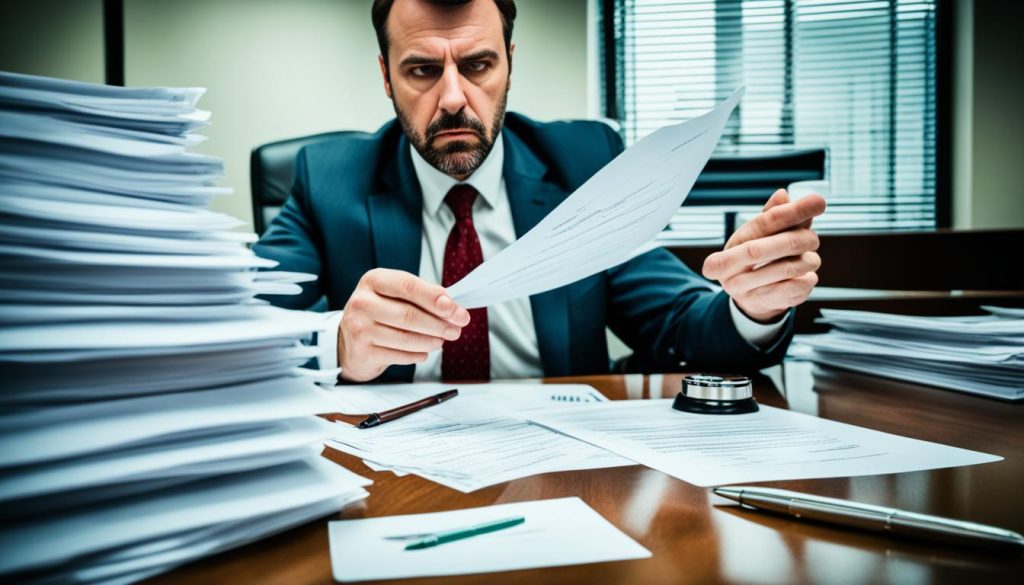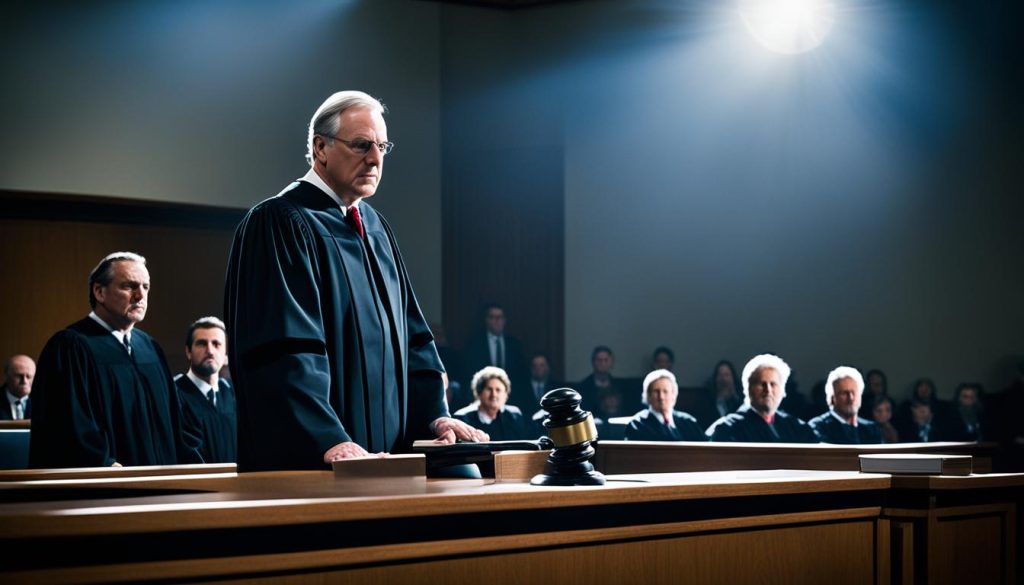Gun violence is a big problem in the U.S., leading to tragic events that often end up in court1. For many, this marks their first step into the complex world of the criminal justice system. This guide aims to simplify the process for you, helping you understand what lies ahead1. Remember, the exact steps and rules can change from place to place. Always look for advice from your local District Attorney’s office or victim support program.
Key Takeaways
- The criminal justice system can be complex and confusing, especially for those experiencing it for the first time.
- Crime is often not discovered or reported to the police, and the identification and apprehension of suspects can be variable1.
- Pretrial release and detention decisions depend on various factors, and some defendants may be eligible for diversion programs1.
- The grand jury plays a crucial role in determining whether there is enough evidence to bring the accused to trial1.
- The criminal justice process is designed to protect individuals from undue state intervention, with various constitutional guarantees in place1.
Understanding the Criminal Justice Process
As a crime victim, knowing the criminal justice process and your rights is key. The Victims of Crime Act, passed in 1984, gives victims certain rights. These rights include being treated with dignity, being informed, protected, and having the chance to apply for compensation and restitution2.
The Victims of Crime Act and Your Rights
The Victims of Crime Act makes sure victims are treated fairly and with respect during the criminal process. This law sets out rights to help victims understand the complex criminal justice system2.
- The right to be treated with dignity and respect
- The right to be informed about the criminal justice process and your case
- The right to protection from the accused
- The right to apply for victim compensation and restitution
- The right to a speedy trial
Law Enforcement’s Role in the Process
When a crime is reported, police go to the scene to figure out what happened. They collect evidence and decide if they should arrest someone3. If there’s enough evidence, they might arrest someone and give the case to prosecutors3.
Agencies like the EPA and FBI help investigate environmental crimes3. Police usually need a search warrant with probable cause to search places during an investigation3.
After investigating, the prosecutor decides if they’ll charge the suspect. This can happen through a grand jury, which decides if there’s enough evidence for an indictment3.
Filing Charges and Arraignment
When police collect enough evidence, they either give it to the prosecutor or draft a criminal complaint. This is done for an arraignment hearing with the suspect4. The prosecutor then decides if to go ahead with the case and what charges to file.
If the prosecutor chooses to proceed, they file a criminal complaint. This includes the charges, crime details, defendant names, and facts4. At the arraignment, the defendant learns the charges and their rights. They then plead guilty or not guilty.
The Prosecutor’s Role in Charging Decisions
The prosecutor is key in deciding on charges. They look at the evidence and decide if it’s strong enough for charges4. In most cases, defendants have the right to a quick trial. The prosecutor must file charges within 48 hours if the defendant is in custody4.
For misdemeanors, trials start within 30 days if the defendant is in custody at arraignment. If not, it’s 45 days4. For felonies, the prosecutor must file the Information within 15 days after the preliminary hearing. Trials start within 60 days of arraignment4.
Defendants can choose to waive their right to a speedy trial4. This means the trial can start later, within 10 days for misdemeanors and after 60 days for felonies4. If found guilty, the defendant will be sentenced4.
The prosecutor’s decisions on charges are very important. They must look at the evidence carefully to make sure the charges fit the crime4. The prosecutor’s role is key to a fair and just outcome for everyone4.
criminal court, legal process, court proceedings, criminal trial
If the defendant says they are not guilty, the case goes to a criminal trial. Here, a jury will listen to evidence and arguments about the crime5. The state’s side is presented by the prosecution. Survivors might find it hard to understand that the prosecution doesn’t represent them or their families. They aim to keep everyone safe by catching criminals.
In federal cases, a jury trial is a right for defendants5. They can ask for bail, which a judge sets based on the crime’s seriousness5. Prosecutors can charge someone through an information, a grand jury, or a complaint5.
The part of a criminal case with motions and hearings can take a long time5. If the prosecution proves the defendant is guilty, they could face prison, fines, or probation6. The judge decides the punishment, following guidelines for minimum and maximum sentences5.
In a jury trial, people are picked randomly to see if they can be fair jurors6. The jury decides if someone is guilty or not, and sometimes the penalty. A judge then formally sentences the defendant6. If the jury can’t agree, the case might end in a mistrial5.
| Offense Type | Penalties |
|---|---|
| Felony | Severe penalties, such as prison time |
| Misdemeanor | Lesser penalties, such as fines or probation |
| Summary Offense | Least severe penalties, often fines |
The Speedy Trial Act says trials must start within 70 days of an indictment7. The Sixth Amendment gives the right to a public trial by a fair jury7. The Batson v. Kentucky ruling stops removing jurors because of their race7.
The Double Jeopardy Clause stops charging someone with the same crime twice on the same facts7. The Gideon v. Wainwright case made sure everyone gets a lawyer in criminal cases7. Not getting good legal help can lead to a new trial7.
The Fifth Amendment lets defendants not answer questions that could make them look guilty7. After arrest, a judge sets bail so the defendant can leave jail, refundable if they show up for court7.
Plea Bargains and Agreements
In the criminal justice system, plea bargains and agreements are key in solving cases8. About 90-95% of criminal cases in the U.S. end with a plea bargain, says the Department of Justice’s Bureau of Justice Assistance8. This shows plea bargains are a common way to settle cases before a full trial8.
A plea agreement is when the defense and prosecution make a deal. The defendant agrees to plead guilty or no contest for a lighter charge or sentence9. Not all prosecutors talk about a plea deal with survivors before offering it to the defense8. Some survivors might not like a plea bargain if it means a lighter charge or sentence than they think is fair.
Plea bargains can take different forms, like charge bargains, sentence bargains, count bargaining, and fact bargaining.9 Charge bargains reduce the seriousness of the charges, and sentence bargains lessen the punishment9. Count bargaining means pleading guilty to fewer charges, and fact bargaining means the prosecution overlooks certain factors during sentencing9.
Even with a plea bargain, federal judges can decide the sentence, not just the deal or the prosecutor’s advice8. Diversion programs offer another way to solve criminal cases without a full trial, giving defendants a chance for probation8.
In some places, victims can speak in court before the judge decides on the plea bargain10. Judges can also choose a different sentence than the deal, even if the prosecutor and defendant agree on it10.

Plea bargains and agreements are vital in the criminal justice system, helping to avoid long trials and ease the judicial workload89. But, these deals can have complex effects on victims, defendants, and justice itself10.
Attending Court Proceedings
Victims, their families, and the public can watch court proceedings to see legal arguments and court decisions11. This can be tough, but it’s key for victims to look after themselves and get support11.
There are rules for courtroom etiquette when you’re in court. You should dress well, not talk or use phones, and not disrupt the court11. Victims can also give a written victim impact statement to the court, sharing how the crime changed their life11.
Courtroom Etiquette and Expectations
Following courtroom etiquette rules is important for a smooth court process. This means:
- Dressing neatly and professionally
- Not talking, using phones, or making noise
- Not having outbursts or emotional reactions
- Respecting the judge and following their rules
By doing this, victims and their families help keep the court respectful and serious11.
Going to the trial can be hard and emotional for victims. They should look after themselves and get support from advocates or other places11. Victims can also give a written victim impact statement to the court, sharing how the crime impacted their life11.
| Courtroom Etiquette Expectations | Victim Attendance Considerations |
|---|---|
|
|
By following courtroom etiquette rules, victims help make the court proceedings respectful and dignified11. Victims should know their rights and the support available to them during the legal process111213.
Conclusion
Navigating the criminal justice system can feel overwhelming, especially for crime survivors. But, knowing your rights14, the roles of key players15, and what to expect16 can make you feel more ready and able to speak up for yourself. You’re not alone in this journey.
Victim assistance programs, mental health experts, and your loved ones offer great support during court. Use these resources to deal with the emotional impact and make sure your voice is heard. The criminal justice system might not always give you the results you want. But, being informed and taking care of yourself helps you move forward with confidence15.
The criminal justice process is complex, but your well-being and safety are most important. Keep connecting with support systems and focus on healing yourself. This way, you can come out of this experience stronger and with a better understanding of the criminal justice system. Your journey shows your strength and determination. Be proud of yourself for seeking justice and closure.
FAQ
What is the Victims of Crime Act and what rights does it provide?
The Victims of Crime Act was created in 1984. It gives victims certain rights that differ by state. These rights often include being treated with dignity, informed, protected, and having the chance to apply for compensation and restitution. Victims also have the right to a speedy trial.
What is the role of law enforcement in the criminal justice process?
Law enforcement officers first respond to a crime. They then investigate to figure out what happened. They collect evidence and decide if they should arrest a suspect.
If there’s enough evidence, they arrest the suspect. Then, they give the case to the prosecutor’s office for review.
What happens after law enforcement gathers evidence?
After gathering enough evidence, law enforcement either gives it to the prosecutor’s office or prepares a complaint. They present this to a judge along with the suspect for arraignment.
What is the prosecutor’s role in the criminal justice process?
The prosecutor then decides if to pursue the case and what charges to file. If they continue with the case, they file a criminal complaint. This complaint lists the charges, crime location and time, defendant’s name, and the crime details.
What happens at the arraignment hearing?
At the arraignment hearing, the defendant learns about the charges and their rights. They then enter a plea of guilty or not guilty.
What is a plea deal or plea agreement?
A plea agreement is when the defense and prosecution agree. The defendant pleads guilty or no contest in exchange for a lighter charge or sentence. Prosecutors might talk about a plea deal with survivors before offering it to the defense.
What should I expect when attending court proceedings?
When attending court, dress neatly and avoid talking or using cellphones. Don’t disrupt the proceedings. If you’re attending the trial, it can be emotional. So, take care of yourself and get emotional support.
Source Links
- The Justice System
- Criminal Cases
- Criminal Justice Process
- How Criminal Cases Work – criminal_selfhelp
- Stages of a Criminal Case
- How the Courts Operate | Learn
- criminal procedure
- plea bargain
- Plea Bargains in Criminal Law Cases
- How Judges Review Plea Bargains in Criminal Law Cases
- What to Expect at a Criminal Trial
- Trial
- Rule 43. Defendant’s Presence
- The Law Offices of Jacqueline Goodman
- Stages of a Criminal Trial
- Criminal Trial Procedures: An Overview

